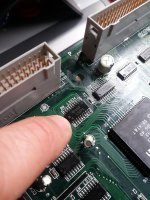Yes.
From my notes, with garbled sound issues I replaced a lot of the LS374s @2N, 2P, 2R, etc. All TI branded.
Ok, time has passed fast again. Meanwhile I got my logic probe digged up, watched couple of videos just a reminder of it's use. Collected all the chips as a list and nassekova collected me the pinouts to a single PDF easier to watch when poking with the probe tip.
Now I finally prepared to make measurements. But another problem arised what I really didn't think earlier (I should have!). If I don't have A and B boards together the CPS2 A board plays pretty much dead. Powers up, but nothing happens (except white picture on screen)... If I put the boards together I can't use the probe as the chips are under the B board...
How did you figure out the faulty chip?






